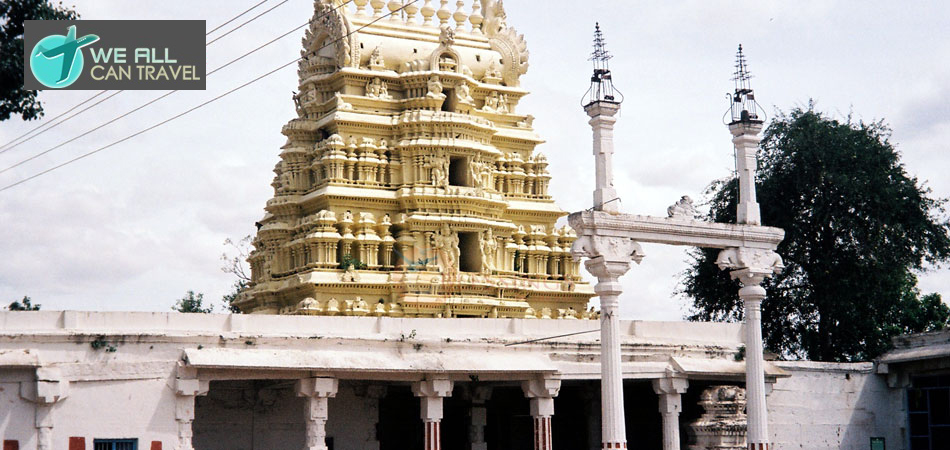Sri Veera Venkata Satyanarayanaswamy Temple
Veera Venkata Sathyanarayanaswami The temple of Sri Veera Venkata Satyanarayanaswamy is the main temple on the Ratnagiri hill. There are also a temple of Sri Rama and the shrines of Vana Durge and Kanaka Durga nearby. The temple of gramadevatha (village deity) is in the village at the foot of the hill.
It is said that Raja I.V.Ramarayanam, the then Zamindar of Gorasa and Kirlampudi Estates near Samalkot, having been ordained by the Lord in his dream, traced the idol on the hill, worshipped it and installed it at the present spot on Sravana Suddha Vidiya of the Telugu year Khara (i.e.) 1891 (Fasli 1301). Then the temple was constructed on the hill with the pleasing and distant view of the Bay of Bengal (11 miles) on one side and the row of Eastern Ghats on the other side the green fields alround the hills and the Pampa River encircling Ratnagiri. The hillock itself is about 300 feet above sea level. About 460 well-laid stone steps lead to the top it.
The main temple is constructed in the form of a chariot with the fur wheels at each of the four corners. In front of the main temple is the kalyana mantapa, constructed and decorated with modern pieces of architecture. As we go down the way,we come across Ramalaya and then the shrines of Vana Durga is held in great veneration and Devi is said to be seen even to this day in the nights, going about the holy precincts perpetually guarding the Lord.
The Akriti of any temple is, according to the Agni Purana, merely a manifestation of the Prakriti. This idea is further developed in the ancient texts, and the entire Slipa Sastra is based on the principle that the wall and the vimana of the temple should be so constructed as to remind a devotee, of the universe, and the Lord inside representing the Supreme Spirit which is the core and being of the entire Universe. According to these tests, the chariot is intended as a symbol of the seven lokas underneath, and the seven lokas above, with the garbhalaya of the Lord, at the hearts center ruling over the entire universe. The temple at Annavaram has been constructed to depict this idea concretely. The front side of the temple depicts the chariot. The Meru on the floor with the pillar at the center, and the idols at the tope are intended to bring forth the idea that the Lord not only remains at the heart's center but also permeates the entire universe. The wheels depicting the Sun and the Moon serve to remind us that this Jaggernaut moves on the wheels of time, and goes on forever and ever. Thus the Annavaram temple satisfies both the ritualistic values and the spiritual aspirations of its devotees." On the north side of the compound of the temple, a sum -everybody constructed dial showing the Indian standard time within the easy calculation. Round the main temple and Kalyanamantapam on a lower level, a mantapam is constructed providing space to conduct one thousand Satyanarayan vrathams at a time in addition to the provision for 500 vrathams by the side of the Ramalya. Opposite to Kalyanamantapam on the east, foundation for a galigopuram is laid. On the south of the compound wall of the main temple by left side while getting up the steps to the temple. Navagrahams are installed and there is a proposal to build a bigger temple for them. Coming down the steps, one finds the office rooms, a guesthouse, a small choultry, and an open-air theatre for Harikathas etc., besides the vratha halls for with the walls painted with figures representing the story of Satyanarayanaswamy and a devotee called Sadhuvu. ON the eatern said of the temple and below the galigopuram, the Kesakhandana sala (shed for tonsure ceremonies) is situated. Behind the maind temple, a new kitchen is constructed for preparing naivedyam to the Lord, in addition to the one that is by the side of Ramalayam for preparing prasadam.
The idol is about 13 feet high in a cylindrical form, the base being in the lower sanctum representing Lord Brahma and the top is in the upper sanctum representing Lord Vishnu. The middle portion represents Lord Siva. There are at some places temples representing Lord Brhama and the tope is in the upper sanctum representing Lord Vishnu. The middle portion represents Lord Siva. There are at some places temples representing the unity of Lords Hari and Hara and this is the place were even Brahma who is generally denied temple worship, is clubbed with the other two, and the creator (Brahma), the protector (Vishnu) and destroyer (Siva) are worshipped simultaneously. The image of the lord forming a single idol representing the Trimurts-Brahma, Vishnu and Siva is of unique attraction.
 >> Agasteeshwara Temple
>> Agasteeshwara Temple >> Anantha Padmanabhaswami Temple
>> Anantha Padmanabhaswami Temple >> Ananthasana Temple
>> Ananthasana Temple >> Annapoorneshwari Temple
>> Annapoorneshwari Temple >> Arunachaleshwar Temple
>> Arunachaleshwar Temple